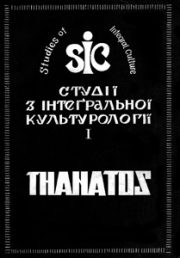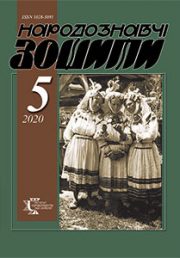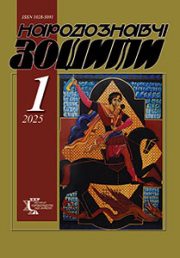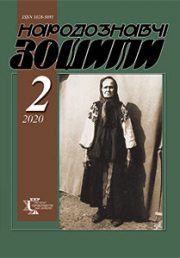The Ethnology Notebooks. 2020. № 2 (152), 450—460
UDK94(477.54) — 058.12: 821.161.2-3 Квітка-Основ’яненко
DOI https://doi.org/10.15407/nz2020.02.450
Aksonova Natalia
ORCID ID: https://orcid.org/0000-0001-8876-2197
Ph.D. of Sciences in History,
assistant professor Department of Ukrainian Studies;
assistant professor Department of Travel Business Regional Studies
V.N. Karazin Kharkiv National University
4, Svobody Sq., Kharkiv, 61022, Ukraine
Contacts: е-mail: aksyonova@karazin.ua
DOMANOVSKYI Andrii
ORCID ID: http://orcid.org/0000-0001-8434-3374
Ph.D. of Sciences in History,
assistant professor Department of Ukrainian Studies;
assistant professor of Ancient and Medieval History Department
V.N. Karazin Kharkiv National University
4, Svobody Sq., Kharkiv, 61022, Ukraine
Contacts: е-mail: andriy.domanovsky@karazin.ua
Abstract. Introduction. The essay analyzes H.F. Kvitka-Osnovyanenko’s short story «A Soldier’s Portrait» («A Grunt’s Portrait») as a source for the study of the ethnography and everyday life of the inhabitants of the sloboda of Lyptsi in the first half of the nineteenth century.
Problem Statement. The value of «A Soldier’s Portrait» stems from the author’s painstaking attentition to the details of folk life, customs, peculiarities of behavior, and other facts. Lyptsi was chosen as the location of the story because the author needed to describe a Ukrainian frontier settlement positioned on the border between Ukrainian and Russian ethnic lands. Certain moments in the story may testify to his familiarity with local, purely Lyptsian details. On the other hand, the writer’s description of a fair can be considered typical of the entire historical region of Sloboda Ukraine.
Methods. The article relies mainly on comparative-typological and historical-cultural approaches as well as elements of structural-typological and geographical methods of ethnology.
Results. The story contains a number of motives the careful analysis of which allows to establish numerous ethnographic details characteristic of a Sloboda Ukraine fair of the first third of the nineteenth century, such as the existence and organization of business in taverns, patterns of behavior of a soldier-moskal, gypsies/Roma, chumaks (long-distance overland carriers of goods), retail traders in various merchandise, and others.
Conclusion. Microhistorical research through the prism of a literary work allows us to look more closely at the problems of the daily life of the peasantry, to study fair customs and beliefs, and to outline the interconnections and ethnic interaction of different sections of the population. Kvitka-Osnovyanenko’s realistic depiction of a Sloboda Ukraine fair in a large, prosperous settlement was to some extent typical of the region.
Keywords: H.F. Kvitka-Osnovyanenko, «A Soldier’s Portrait» («A Grunt’s Portrait»), short story, ethnographic source, fair, trade, everyday life, Sloboda Ukraine, sloboda of Lyptsi, first third of the nineteenth century.
Received 2.02.2020
REFERENCES
Osnov’janenko, Gryc’ko. (1834). Saldac’kij patret (A Soldier’s Portrait). Small lie. Malorossijskie novels. Narrated by Gritsky Osnovyonenko. Prince first one. Moscow [in Russian].
Osnov’janenko, Gryc’ko. (1841). Saldac’kij patret Pobrehen’ka Malorossijskie novels. Narrated by Gritsky Osnovyonenko (Book 2). Kharkiv [in Russian].
Kvіtka-Osnov’janenko, G.F. (1969). Saldac’kij Patret. Small lie. Kvіtka-Osnov’janenko, G.F. Collection of works in eight volumes (Vol. 3). Prose works. Kyiv [in Ukrainian].
Kvіtka-Osnov’janenko, G.F. (1981). Saldac’kij patret. Latin prank, the new story is told Kvіtka-Osnov’janenko G.F. Collection of works: in seven volumes (Vol. 3). Prose works. Kyiv [in Ukrainian].
Vozniak, M. (1846). Hryhorij Kvitka-Osnov’ianenko. Life and creativity. Kyiv [in Ukrainian].
Verbyts’ka, Ye.H. (1857). Hryhorij Fedorovych Kvitka-Osnov’ianenko. Essay on life and creativity. Kharkiv [in Ukrainian].
Zubkov, S. (1961). The founder of new Ukrainian prose. Kvitka-Osnov’ianenko, G. Saldac’kij patret (A Soldier’s Portrait). Kiev [in Ukrainian].
Chalyj, D. (1962). G.F. Kvitka-Osnov’ianenko (Creativity). Kyiv [in Ukrainian].
Honchar, O.I. (1964). Hryhorij Kvitka-Osnov’ianenko. Vignette. Kyiv [in Ukrainian].
Berbyts’ka, Ye.H. (1968) H.F. Kvitka-Osnov’ianenko (Life and creativity). Kharkiv [in Ukrainian].
Pokhodzilo, M.U. (1968). H.F. Kvitka-Osnov’ianenko. Life and creativity: Posibnyk dlia vchyteliv. Kyiv [in Ukrainian].
Honchar, O.I. (1969). Hryhorij Kvitka-Osnov’ianenko. Life and creativity. Kyiv [in Ukrainian].
Sulyma-Blokhyn, O. (1969). Kvitka and Kulish — the founders of the Ukrainian novels [in Ukrainian].
Zubkov, S.D. (1978). Hryhorij Kvitka-Osnov’ianenko: Life and creativity. Kyiv [in Ukrainian].
Dudka, O.O., & Potebna, O. (Ed.). (2000). Emphasis on feminine nouns in accentuated works by G.F. Kvitka-Osnov’ianenko. Bulletin of Kharkiv University. Series of Philology: Traditions of Kharkiv Philological School. To the 100th anniversary of the birth of M.F. Nakonechnoho, 491, 117—123. Kharkiv [in Ukrainian].
Sumtsov, N.F. (1893). Kvitka as an ethnographer. Kyiv antiquity. Monthly historical journal, 2, 190—214 [in Russian].
Sumtsov, N.F. (1902, 2 (15) january). From ethnographic excursions. IX. Lasochi Southfall, 7245, 2 [in Russian].
Sumtsov, N.F. (1884). Slobodsko-Ukrainian nobility in the works of G.F. Kvitki. Kyiv antiquity. Monthly historical journal, 6, 201—209 [in Russian].
Yatyshchuk, O.V. (1999). G.F. Kvitka-Osnov’ianenko as an ethnographer. Ethnicity, Culture, Nation: Proceedings of the International Scientific Conference of the M. Rylsky Institute of Art Studies, Folklore and Ethnography of the NAS of Ukraine (Pp. 57—62). Drohobych [in Ukrainian].
Yatyshchuk, O.V. (2003). Grigory Kvitka-Osnovyanenko in the spiritual history of Ukraine Ternopil [in Ukrainian].
Yatyshchuk, O.V. (2009). Life and customs of the Ukrainian people in the works of G.F. Kvitka-Osnovyanenko: author. diss. … Cand. ist. of sciences. Specialty: 07.00.05. Ethnology. Lviv [in Ukrainian].
Yatyshchuk, O. (2014). Artistic text as an ethnographic source Scientific notes of the Ternopil National Pedagogical University named after Vladimir Hnatyuk. Series: History. Ternopil: V. Hnatyuk TNPU Publishing House (Issue 1, part 1, pp. 209—214) [in Ukrainian].
Bagaley, D.I. (1893). Historical novels and articles Kvitki. Kyiv antiquity. Monthly historical journal, 8, 215—244 [in Russian].
Bagaley, D.I. (1893). Historical novels and articles by Gr. Fed. Kvitka (to the 50th anniversary of his death). In Bagaley D.I. Notes and materials on the history of Sloboda Ukraine (Pp. 46—56). Kharkov [in Russian].
Bagaley, D.I. (1829). F. Kvitka-Osnovyanenko and His Day (Ukrainian Cultural History Page). In Kvitka-Osnov’ianenko. Collection for the 150th birthday. 1778—1928 (Pp. 147—173). Kharkiv: The Ukrainian Worker [in Ukrainian].
Slyusarskiy, A.G. (1972.). Questions of the history of Ukraine in the works of G.F. Kvitka-Osnov’ianenko. Questions of the history of the peoples of the USSR (Issue 14, pp. 140—146) [in Ukrainian].
Yurchenko, V. (2008). Folk customs at the fairs of Ukraine in the second half of the nineteenth — early twentieth century. Ethnic history of the peoples of Europe (Issue 24, pp. 119—125) [in Ukrainian].
Yurchenko, V.A. (2009). Fair in the system of traditional culture of Ukrainians (second half of XIX — beginning of XX century): author. diss. … Cand. ist. of sciences. Specialty: 07.00.05. Ethnology. Kyiv [in Ukrainian].
Yurchenko, V. (2017). Folk customs at fairs of Slobidsky Ukraine. Folk creativity and ethnology, 5, 84—85 [in Ukrainian].
Sheremetev, S.D. (1892). Borisovka Russian Archive (Book 3, issue 10, pp. 199—203) [in Russian].
Shulik, V. (Ed.). (2019). Ukrainian Icon: Sloboda Borysivka of the late XIX — early XX centuries: album. Kyiv: Master of Books [in Ukrainian].
Metka, L. (2010). Pottery of Slobidska Ukraine in the second half of the nineteenth and first half of the twentieth century: assortment and sale of products. Ethnic history of the peoples of Europe (Issue 33, pp. 27—32). Kyiv [in Ukrainian].
Maslov, M.P. (2000). From the History of Folk Art Development in Slobozhanshchina. Pottery. Muravsky Way’2000. Materials of folklore-ethnographic expedition (Pp. 66—79). Kharkiv: Region-Inform [in Ukrainian].
Zuev, V.F. (1787). Travel notes of Vasily Zuev from St. Petersburg to Kherson in 1781 and 1782. St. Petersburg:attached to the Imperial Academy. Sciences [in Russian].
Sumarokov, P.I. (1803). Leisure of the Crimean judge, or Second trip to Taurida (Part 1). St. Petersburg [in Russian].
Dolgorukov, I.M. (1870). The tambourines are glorious beyond the mountains, or my journey somewhere in 1810. Moscow [in Russian].
Sipovsky, V. (1928). Ukraine in Russian Writing (Part 1) (1801—1850). Kyiv [in Ukrainian].
Sichinsky, V. (1991). Foreigners about Ukraine. Lviv [in Ukrainian].
Bagaliy, D.І. (1993). History of Slobidska Ukraine. Kharkiv [in Ukrainian].
Slyusarsky, A.G. (1964). Socio-economic development of the Slobozhanshchina of the XVII—XVIII centuries. Kharkov [in Russian].
Slyusarsky, A.G. (1954). Slobidska Ukraine. Historical sketch. XVII—XVIII centuries. Kharkiv [in Ukrainian].
Tantsyura, V.І., & Peresada, O.O. (2016). History of Slobidska Ukraine: a textbook. Kharkiv [in Ukrainian].
Chorniy, D.M. (2016). History of Slobidska Ukraine: a textbook. Kharkiv [in Ukrainian].
Description of Sloboda-Ukrainian cities and towns delivered to the Catherine Commission to draft a new code of 1767. (1890). In Bagaley D.I. Materials for the history of colonization and life of the Kharkov and partly Kursk and Voronezh lips. Kharkov [in Russian].
Description of cities and noble towns in the provinces of the Sloboda province in 1767—1773. (1890). In Bagaley D.I. Materials for the history of colonization and life of Kharkov and partly Kursk and Voronezh lips. Kharkov [in Russian].
Pirko, V., Gurzhiy, O., & Sohan, P. (Ed.). Topographical description of Kharkiv governorate of 1785. (1991). Descriptions of Kharkiv governorate of the late eighteenth century: Descriptive-statistical sources. Academy of Sciences of the Ukrainian SSR; Archeogra. commission and others. Kyiv [in Ukrainian].
Chulkov, M.D. (1786). Historical description of Russian commerce; at all ports and borders from ancient times to the present, and all the prevailing legalizations of the sovereign Emperor Peter the Great and the now reigningly reigning Sovereigns of Empress Catherine the Great, composed by Mikhail Chulkov (Vol. 6, book 4). Moscow [in Russian].
Chulkov, M.D. (1788). Dictionary of fairs and tenders established in Russia. New and complete geographic dictionary of the Russian state, or Lexicon. Moscow [in Russian].
Belinsky, M.V. (to his wife). Kharkiv, 1846, June 14. (1956). In Belinsky V.G. Complete works (Volume XII). Letters 1841—1848. Moscow. Retrieved from: http://az.lib.ru/b/belinskij_w_g/text_3900.shtml. (date of the beasting 1/16/2020) [in Russian].
Bargaining for the sale of spirit. (1894, 17 (29) november). South Land, 4764 [in Russian].
Shevelyov, Y. (1943, 1 august). Before the Court of the Century. Our days [in Ukrainian].
Skoryak, A. (2012). Functional and artistic specificity of Ukrainian fair folklore. Materials on Ukrainian Ethnology (Issue 11, pp. 37—42) [in Ukrainian].
Kudinova, A. (2015). The custom of «Mogorych» in the fair and everyday culture of Ukrainians (based on the materials of the AF Kistyakovsky Foundation). Interdisciplinary Humanities Studies. Avg.: Historical sciences (Issue 2, pp. 83—84) [in Ukrainian].
Yurchenko, V.A. (2014). Fair in the system of traditional culture of Ukrainians (second half of XIX — beginning of XX century). Kyiv [in Ukrainian].
Yurchenko, V. (2009). Traditions of nutrition at the fairs of Ukraine in the second half of the nineteenth — early twentieth centuries. Ukrainian Studies, 1, 221—225 [in Ukrainian].
Sumtsov, M. (1890). Slasteny, makovniki and other common «lasoshhi». Cultural experiences (Pp. 107—109). Kyiv [in Russian].
Artyukh, L. (1982). Folk feed of Ukrainians and Russians of north-eastern districts of Ukraine. Kyiv [in Ukrainian].
Artyukh, L. (1993). From the history of national cuisine. Mandryly. Shulyky. Slast’ony. Pundyky. Burning blackberry. Neopalyma kupyna, 2, 23—27 [in Ukrainian].
Yatyshchuk, O. (2011). Ukrainian folk cooking of the 18th — early 19th centuries: based on the works of art by G.F. Kvitka-Osnovyanenko. Scientific notes of the Ternopil National Pedagogical University named after Volodymyr Hnatyuk. Avg. History (Issue 2, pp. 194—220) [in Ukrainian].
Dictionary of the Ukrainian Language: in 11 volumes. (1973). (Volume 4). Kyiv [in Ukrainian].
Ihnenko, V.M. (2012). Slobozhanshchina industry in the pre-Soviet era. Collection of scientific works of Kharkiv National Pedagogical University named after G.S. Skovoroda. History and Geography Series (Issue 45, 158—164). Kharkiv [in Ukrainian].
Chicherov, V.I. (1957). The winter period of the Russian national agricultural calendar of the XVI—XIX centuries. (Essays on the history of popular beliefs). Moscow [in Russian].
Kononenko, O. (2017). Ukrainian mythology. Folklore, fairy tales, customs, rituals. Kharkiv [in Ukrainian].
Sharovkin, I. (Ed.). (1896). Legal customs of peasants of the Pecheneg volost of the Volchansky district of the Kharkov province. Kharkov [in Russian].







